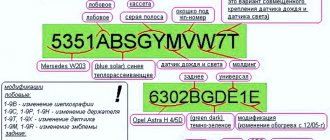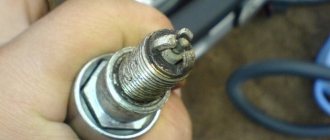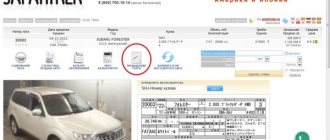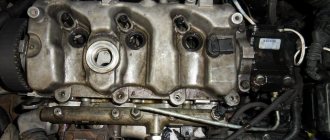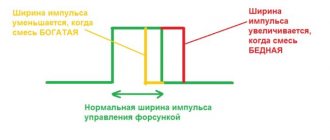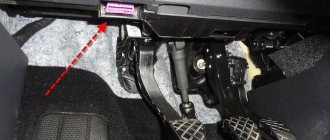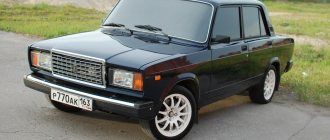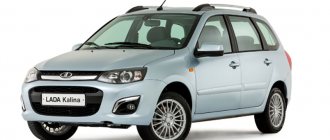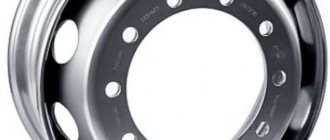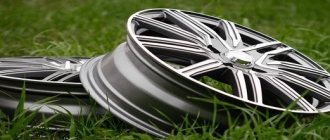What information is contained in the inscriptions on car rims?
Strictly speaking, the “discs” that we buy in auto parts stores are not actually discs at all, but wheels.
And the “disc” marking is usually applied not to it, but to the wheel rim. A careful study of the markings will help you not only make sure that this design has been tested and its use will be safe, but also understand whether the wheel is suitable for installation on your car.
All disks, regardless of whether they are cast or stamped, have standard markings. In any case, the designation must contain:
- the Latin letter I or S, indicating whether the wheel is “identical” (I), that is, exactly the same as the wheels that were installed on production cars, or special (S), which was certified without being “linked” to any car . For elements that were included in the certified vehicle (original), the letter marking is not applied, but they may indicate the designation of the vehicle manufacturer and the spare parts catalog number;
- manufacturer's name or trademark;
- wheel rim profile designation;
- rim offset size in millimeters;
- date of manufacture (at least month and year);
- serial number (designation).
The rim marking consists of the following symbols:
- rim contour (shape of the side flange);
- nominal diameter (usually in inches);
- nominal width (also usually in inches);
- symbol of a one-piece rim (on all modern passenger cars the one-piece rim is the “x” sign).
The marking of wheel rims from all manufacturers is subject to the same rules.
How to choose the right disk
In addition to PCD, there are a number of other nuances that you need to pay attention to when choosing the right discs. You need to know the width and diameter, the overhang size, and the diameter of the car's hub. The more accurately these data coincide with the recommended characteristics of the manufacturers, the better. You can find out these parameters from catalogs or by measuring yourself. If you decide to measure the characteristics of the disk yourself, be especially careful.
Unfortunately, all these characteristics can differ quite significantly for cars of different brands. Therefore, it is very imprudent to install Mazda wheels on a Ford. Even if they match in diameter, the similarity will be limited to that. Wheels of different brands are very different from each other, which is why experts recommend buying only original wheels from trusted suppliers.
Types of rims
Types of rims
Depending on the material of manufacture and production technology, there is the following classification of wheel rims:
- stamped;
- cast;
- forged;
- compound.
They are considered the simplest and most accessible. Structurally, they are stamped steel parts welded to each other.
Pros of this type:
- Acceptable price.
- Relatively high strength.
- Possibility of recovery even in the event of a strong blow.
The disadvantages include:
- Unpretentious design.
- Large mass.
- Low resistance to corrosion.
Alloy wheels
Alloy wheel on a car
Alloy wheels (sometimes called alloy wheels) are made from aluminum or magnesium alloys. These discs are highly durable and well balanced. In addition, they have a beautiful appearance. If in a steel wheel the disk itself is connected to the rim by welding, then an alloy wheel is a single product.
The importance of choosing the right drives
Every motorist wants to use the best and highest quality components in his car. And if the installation of, for example, an audio system does not raise any questions, then parts that affect traffic safety should be selected taking into account the permissibility of their installation in a given car.
This category of parts refers to unsprung mass, which directly affects the behavior of the car when driving.
The correct choice of discs affects the acceleration dynamics, vehicle handling and reliable suspension performance. Therefore, when choosing wheels, you need to take into account the recommendations of the vehicle manufacturers, and not look at their color. Invaluable assistance in choosing will be provided by deciphering the markings of wheel rims, the knowledge of which drivers need.
Disc markings
Stamped and cast wheels for passenger cars have the same standard designation (marking). Disc certification in EU countries is carried out in accordance with UN/ECE 124.
As an example, you can decipher one of the wheel rim marking options: 7.5 J x 15 H2 5x100 ET40 d54.1
Rim width The number 7.5 in the example marking indicates the distance between the inner edges of the rim in inches. This indicator is taken into account when choosing tires, since each tire has a certain rim width range. It is best when the rim width is in the middle range of the tire.
Rim flange type The Latin letter J in the disc marking indicates the shape of the rim flange. This is where the disk connects to the bus. Among the most common designations for passenger cars are: P, D, B, K, JK, JJ, J. Each letter hides several parameters:
- radius of curvature,
- profile contour shape,
- shelf angle,
- height of shelves, etc.
Most often in modern passenger cars, a J-shaped flange is found. All-wheel drive models are usually equipped with wheels with the JJ type designation.
The flanges of the rim of the wheel affect the mounting of the tire, the weight of the balancing weights, and the tire's resistance to displacement in extreme situations. Therefore, despite the external similarity of JJ and J wheels, you need to give preference to the rim edge recommended by the automaker.
Detachability of the rim The “x” sign indicates that the rim is made in one-piece form and is a single unit, and the “-” sign indicates that it consists of several components and can be disassembled and reassembled. One-piece disks differ from collapsible designs in lightness and greater rigidity.
Wheels with an “x” rim are designed to be used with elastic tires, which is typical for cars and small trucks. In the case of truck tires, which are characterized by rigidity, split rim designs are required. There is simply no other way to mount a tire on a wheel rim.
Mounting diameter (rim diameter) Mounting diameter is the size of the wheel rim for the tire.
The mounting diameter is usually indicated in inches (in our example it is number 15). In everyday life, motorists also call it the radius of the disk. When selecting a tire, this indicator must coincide with its mounting size.
Standard values for mounting disk diameters for passenger cars and crossovers will be from 13 to 21.
Ring projections or tackles (hump) The designation H2 is deciphered as follows. Annular projections (hamps) are located on both sides of the disk. These mounts are designed to secure a tubeless tire to a rim. They prevent the outflow of air in the event of external impact on the tire. Other designations are also used: H – the hump is only on one side, FH – the tackle has a flat shape (Flat Hump), AH – the protrusion has an asymmetric shape (Asymmetric Hump), etc.
Location of mounting holes (Pitch Circle Diameter) In the 5x100 marking, the first number indicates the number of holes in the wheel rim. The number 100 indicates the diameter of the circle on which the mounting holes are located.
- The number of mounting holes for passenger cars usually ranges from 4 to 6 pieces.
- Standard values for the diameter of a circle will be 98 ÷ 139.7.
It is not always possible to determine by eye the correspondence between the size of the hub and the disk. And installing a 98 disk instead of a 100 can lead to a misalignment of the wheel, which will cause runout, as well as spontaneous unscrewing of the bolts.
Disc offset (ET, Einpress Tief) Disc offset is the distance between the plane of contact of the disc with the hub and the plane that passes through the center of the cross section of the wheel rim. The value is expressed in millimeters, and the offset can be both positive (ET40) and negative (ET-30).
This indicator must comply with the car manufacturer's recommendations, otherwise in an emergency, the forces acting on the suspension may break the disc.
Hub diameter (DIA) The central (hub) mounting hole of the wheel rim is indicated in millimeters, for example d54.1. The diameter of the mounting hole in passenger cars ranges from 50 to 70 mm. It is very important to accurately select the disc in accordance with the fit of the vehicle's hub.
Even with minor deviations of one of the wheel rim parameters from the car manufacturer’s requirements, there is a threat of accelerated tire wear, which can lead to its destruction in an extreme situation (high speed, sharp braking, sharp turns).
If your car stops due to engine fault, you can call a tow truck, a mechanic, or hitch a ride for help. But when a tire ruptures or a wheel comes off the hub at high speed, this creates a danger to the life of the driver, passengers and other road users. Therefore, the wheels must always be in good condition and under constant control of the driver.
7.5 J x 15 H2 5x100 ET40 d54.1
We will decipher this example further.
Rim Width “7.5” is the mounting width or distance between the edges of the disk, measured in inches. Converted to the metric system, it turns out 7.5 * 25.4 = 190.5 millimeters. It should be noted that each tire has a certain range of permissible (recommended) rim width. The optimal width will be closest to the middle of the specified range. Otherwise, problems with beading of tires may arise, and its characteristics will deteriorate.
Flange (edge type) The letter “J” (may be found: P, D, B, K, JK, JJ, J) contains information about the flange of the rim, which indicates information about the height and inclination of the flanges, the radius of curvature, the design and shape of the profile . The most common flange types today are "J" and "JJ". The first are intended for single-wheel drive cars, the second - for all-wheel drive.
Detachable rim The symbol “x” indicates the one-piece (monolithic) type of the wheel rim. Otherwise, the disk is marked with a “-” sign, which indicates the presence of several components for which it can be disassembled if necessary. Note that one-piece structures are more rigid and lightweight compared to collapsible ones.
The “x” marking also indicates that these wheels are intended to be equipped with elastic tires, which are used on passenger cars and light trucks. Rubber for large trucks is rigid and requires discs of a composite design for installation, otherwise mounting on the rim becomes impossible.
Rim Diameter (mounting diameter)
The next number “15” is an indicator of the parameters of the landing rim for tires, calculated in inches. This size is often also called the radius of the disk. In the process of selecting and purchasing a tire, you must ensure that this parameter absolutely matches the corresponding tire size. Note that the range of diameters under consideration for ordinary (standard) passenger cars and SUVs ranges from 13-21 inches.
Hump (rolls and protrusions) The so-called “humps” (H2), or otherwise annular protrusions, are located on both sides of the disk, and are designed to fix tubeless automobile tires on it. Rolls prevent the outflow of air from under a tubeless tire when exposed to external influences. In addition to the example and considered case with “H2” with a double-sided arrangement, there are tackles of the following types:
- H - on the only side of the disk.
- FH (Flat Hump) - with a flat shape.
- AH (Asymmetric Hump) - with an asymmetrical protrusion.
Pitch Circle Diameter, PCD (mounting holes) In this case, the designation “5x100” indicates the location of the disk holes intended for fastening it to the car axle. The values "5" and "100" indicate the number of these holes and the diameter of the circle of their location, respectively. For passenger vehicles, the number of these holes can vary from 4 to 6, while the standard circumference diameters for their location are in the range of 98 - 139.7 millimeters.
Einpress Tief, ET (disc offset)
The designation “ET40” in this case defines the disc offset, which is the distance between two planes passing through the contact surface of the hub with the disc and through the cross-section center of the disc itself (transverse), respectively. This distance is measured in millimeters. At the same time, the offset can be both positive and negative (ET40, as in our case, or for example ET-25).
Hub Diameter, DIA (landing diameter) Marker “d54.1” is the diameter of the central hole of the wheel rim, otherwise called the landing or hub. It is indicated in millimeters, and for passenger vehicles ranges from 50-70 mm. This parameter is very important, and therefore must fully correspond to the belt of the car hub.
Disk options
To determine what the marking means, you need to know the width and diameter of the wheel product.
Drilling or bolting
This is one of the most difficult parameters to study, indicating the diameter of the mounting bolts. Drilling is measured from the center area of the stud to the opposite area where the element is located on the wheel.
Quite often, manufacturers indicate the disc bolt pattern parameters using shot depending on the number of holes for fastening. Let's assume the figures are 6/222.25. The first number shows the number of drillings for fastening the bolts, and the second number indicates the drilling in millimeters.
Disc offset
This indicator is marked in English letters ET and indicates the distance from the plane of the wheel product to the middle zone of the rim. The mating surface of the wheel product indicates the pressing plane of the disk to the hub.
Departure parameters can be:
- with zero indicator;
- with negative;
- with positive.
Zero offset indicates that the plane of the disc corresponds to its middle zone. Thus, the lower the indicator, the more the wheel product protrudes from the outside of the car. If the overhang indicator is increased, this means that the disc is deeper into the interior of the car.
It is also necessary to take into account the fact that depending on the width of the product, the overhang indicators differ. Manufacturers indicate in the documentation accompanying the vehicle a smaller offset value for wheels with a large width.
What is HUMP(H)?
The hump is the protrusion of a ring on a disc rim. This element is used as protection against car tires coming off. Usually 2 humps (H2) are used for a wheel. In some cases, a hump may not be used or only one may be used, depending on the vehicle configuration. Types of Humps:
- combined (CH);
- flat (FH);
- asymmetrical (AH).
PCD Disc Parameters
The PCD value refers to the diameter of the circle of the center holes on the wheel rim. That is, this is the diameter of the holes for fastening the bolts.
DIA drive option
The DIA parameter indicates the diameter of the hole located in the center of the disk. Casting manufacturers prefer to create a large DIA center hole diameter. This is done to ensure that the wheels are applicable and universal for all types of cars. Despite the fact that the size of the hub may differ depending on the vehicle model, the auto disk is installed using an adapter ring or bushing.
Decoding the symbols on the wheels of a passenger car
For example, on the car disk we found the following entry: KrKZ UA 16 06 5 1 / 2 JxH2 ET47 560 226.15. We read:
- KrKZ - Kremenchug Wheel Plant;
- UA - Ukraine;
- 16 06 - June 2020;
- 5 1/2 - rim width 5.5 inches;
- J is the shape of the side flange of the rim. As a rule, rims with a diameter of 13 inches or more have a J flange shape, smaller ones - B;
- x—one-piece rim;
- H2 - design of the landing flanges: H means the presence of a special protrusion for the use of tubeless tires, 2 - that such a protrusion is made on both the outer and inner sides of the rim (if there is no number 2, then the protrusion H is only on the outer side of the rim) . For tubeless tires, in addition to the H lug design, there are wheels with the FH design.
- ET47 - rim offset 47 mm. Overhang is the distance that needs to be measured from the mating plane of the disk to the central plane of the rim;
- 560 - maximum static load on the wheel 560 kilograms;
- 226.15 - factory designation of the wheel.
In addition to the mandatory marking signs, the wheel is usually marked with a symbol for the mounting dimensions of the disks:
- LZ - number of mounting holes;
- PCD - hole location diameter;
- DIA is the diameter of the central hole.
Often the number of mounting holes is indicated along with the PCD in the form of 4x98, 5x112, etc.
All major wheel sizes must comply with the vehicle manufacturer's recommendations.
When choosing rims, it is necessary to take into account both their technical characteristics (such as diameter, rim width and other indicators), as well as the quality and origin of the rims themselves. Otherwise, the purchase depends on the preferences of the car enthusiast and his willingness to part with a certain amount when purchasing wheels.
Standard characteristics of car wheels and their letter indices.
Manufacturers endow any disk with a number of characteristics that are reflected in its marking, usually these are:
- Hump type (denoted by the letter “H”);
- X-factor (denoted by the letter “X”);
- internal disk surface (indicated by the letter “S”);
- the edge of its seat (indicated by the letter “F”);
- number of available mounting holes (indicated by the letter “N”);
- diameter of the location of the mounting holes (indicated by the letter “C”);
- rim width (indicated by the letter “A” and measured in inches);
- disc offset (indicated by the letter “E” and calculated in millimeters);
- the diameter of the main (central) hole (indicated by the letter “D” and calculated in millimeters);
- disc rim diameter (indicated by the letter “B” and calculated in inches).
Disc width
6.5 - (B) - indicator of the width of the disk in inches (the indicator of the width of the disk in the marking is sometimes indicated as a fraction of 6 and 1/2).
Width is measured along the so-called rim flange on which the sidewalls of the tire are laid, and not along the outer sides of the rim or from edge to edge.
The width of the rim must strictly correspond to the width of the tire, so that after installing the tires on the rims, they have the optimal shape specified by the manufacturer. You can calculate the required rim width using a tire calculator.
The letter L indicates the shape of the side flange of the rim (JJ, JK, J or K). When choosing a car wheel, buyers do not take this parameter into account, so they do not pay special attention to it.
Additional markings
In addition to standard designations, when choosing disks you may come across the following abbreviations:
- MAX LOAD – a parameter that shows what maximum load is allowed on the disks;
- MAX PSI 50 COLD - indicates that the tire pressure should not exceed 3.5 kgf/sq.cm. COLD is a reminder that the tire pressure should only be measured when the tire is cold;
- FORGET – indicates that the disc was made by forging;
- BEADLOCK – the disc is equipped with a tire locking device. It is prohibited to use such products;
- BEADLOCK SIMULATOR – states that the disk is equipped with a system that simulates a “beadlock”. This element is rather decorative in nature, so such models are no different from ordinary disks;
- SAE/ISO/TUV is a marking of a regulatory body indicating that products comply with international standards.
In addition, the disc may indicate the date of manufacture. The first two digits are the week, and the subsequent ones are the year. For example, 0510 means that the product left the assembly line in the 5th week of 2010.
Disc diameter
The diameter of the disc in inches is designated 15 - (D). Here you should pay attention that we are talking about the diameter of the “flange” of the disk on which the tire bead is placed. That’s why if you want to use a tape measure to determine the outer diameter of a car rim, you will have to take into account that in reality the actual value is somewhat smaller. In order to determine the diameter of the disk in inches, you need to divide the resulting number in centimeters by 2.54.
So, if you measured 40.6 centimeters: disk diameter = 40.6 / 2.54 = 16 inches.
Humps are small annular protrusions located on the rim. They serve to keep the tubeless tire from coming off the rim, preventing the tubeless tire from coming off the rim. Usually there are 2 humps on the wheel, but sometimes there is one. When selecting a disk, this parameter is not taken into account.
The H2 code displays the design and number of humps. Hump options:
- H – simple hump;
- H2 – double hump;
- FH – flat hump;
- AH – asymmetric hump (Asymmetric Hump);
- CH - Combi Hump.
DIA disk
Many manufacturers of DIA alloy wheels produce larger diameters, and adapter rings are used for alignment on the hub. These rings can be made of plastic or metal. Plastic rings are less durable, but have a big advantage over aluminum adapter rings. Taking into account the cold Russian winters, plastic rings that do not oxidize, the cast disc does not “stick” to the hub.
Important!
1. The disk DIA (hub hole diameter) on a steel (stamped) disk must correspond to the recommended value (+ - 0.1 millimeters), since adapter rings are not used on steel disks.
2. On a cast or forged disk, the diameter of the hole for the hub is determined using a plastic bushing (adapter ring), which is selected directly for your machine after the disk model is selected.
3. Original wheels installed on a car by the manufacturer usually do not provide for the installation of adapter rings. They are manufactured at the same time to the desired center hole diameter DIA.
PCD disc (bolt pattern)
Disc bolt pattern (PCD) – disc mounting parameters: 5x112, where the first digit indicates the number of nuts (or bolts). In the example given, this number is 5.
The second number indicates the diameter at which the nuts are located (in millimeters). This value is called Pitch Circle Diameter (PCD). In the example given, it is 112 millimeters.
When talking about tires, to make the task easier, the term PCD often refers to both of these parameters at once, and to indicate the PCD of the disk - 5/112.
If necessary, the PCD of the wheel is calculated by measuring the length between the centers of the far mounting holes (use a simple ruler, without even removing the wheel from the car).
• The distance (PCD) between discs having 4 mounting bolts (or nuts) is equivalent to the distance between the centers of the opposite (farthest) bolts or nuts.
• Discs with 5 mounting bolts (or nuts) are distinguished by the PCD of the disc, equal to the distance between the centers of the farthest (not adjacent) bolts or nuts, multiplied by 1.051.
Important! PCD should be measured as accurately as possible, since the values can be very close (98 and 100; 110 and 112), and one cannot be used instead of other indicators! You can find detailed instructions on how to measure disk parameters as accurately as possible in the section: “Measuring disk parameters.”
Bestsellers
Disc offset (ET)
The ET39 symbol indicates the offset or offset of the disc (OFFSET and DEPORT markings are also possible). The term “disc offset” refers to the length between the mating plane of the wheel rim (the plane of which the disc is adjacent to the hub) and the middle of the rim width.
Wheel rim offset (ET marking) is measured in millimeters. There are discs with negative and positive offset. The disc offset is equal to 0 if the center of the disc is identical to the plane of attachment of the disc to the hub. In the case we are describing, ET has a positive value and is equal to 39 millimeters.
- Positive overhang is caused by the mating plane being shifted back from the middle of the disk width.
- Zero offset - no displacement of the mating plane relative to the middle of the disk width.
- Negative offset is characterized by a displacement of the mating plane forward from the middle of the disk width.
Typically, the offset of a car rim is related to the width of the rim, since as the rim width increases, the ET is reduced, thereby moving the rim outward of the car so that it does not come into contact with the shock absorber strut and other suspension parts.
However, a very low offset will increase the load on the wheel bearings and certain values can cause the tire to rub against the car's fender, especially if the suspension is activated. This is worth considering when choosing wheel spacers.
An excessive offset value will immediately prevent the disc from being installed on the car, since the inner part of the disc will rest against the brake caliper or other parts of the car’s suspension.
What should I do to find out the permissible disc overhang? Follow the instructions of the vehicle manufacturer and the use catalogs of different wheel manufacturers. The catalogs contain information about which specific cars correspond to a given disc and what certificates confirm this.
If the catalog contains information that a certain disc is suitable for your car and has an international certificate (for example, TUV), then you can safely install such discs on the car, and the car dealer will not be able to make claims to you and remove the car from warranty service .
Important! Car owners often experience difficulties, mistakenly believing that if a parameter is called “offset,” then the larger its size, the more the wheel will protrude outside the car. But in reality, everything happens completely differently: the smaller the disc offset, the more part of the wheel will move outward.
Parameter d57.1 displays the diameter of the central hole, measured from the mating plane. This parameter is called disk DIA. The DIA diameter is measured in millimeters, and in this case its value is 57.1 millimeters.
- Disk options. Decoding the markings of wheel rims for passenger cars
Tags: disk, wheel, marking
- Related Posts
- Vehicle registration number
- Apply for car registration through government services
- Fine for expired licenses in 2020: what the threat is and what the punishment is
« Previous entry
What does parameter 700c mean?
This designation is used for large types of wheels on SUVs and Nivas. According to the accepted ISO classification, this figure is 29 inches. Typically 700c wheels are used for off-road racing.
Due to the use of 29 inch wheels:
- management indicators are improved;
- braking distance on unpaved surfaces is reduced and aerodynamics is increased;
- the vehicle's cross-country ability on soft soils and sand increases;
- it becomes possible to install powerful brakes.
To select wheels that match a particular type of car, it is recommended to determine the diameter of the wheel and analyze the markings indicated on the rim. Also, do not forget that safe driving ultimately depends on this element.
If you want to change the wheels on your car, then you need to know a few important things to make the right choice. Let's look at the markings of car wheels. All wheels have standard parameter markings, regardless of whether it is an alloy or steel wheel.
Wheel rim markings
For example: 8.5Jx18 H2 5×120 ET20 d74.1
- 8.5 – is the width of the rim in inches (W);
- 18 – is the diameter of the disk in inches (D);
- 5×120 - this is a designation of the number of landing bolts and the diameter at which they are located. This diameter is also referred to as PCD, and is measured in millimeters. In our case, the number of landing bolts is 5 and the PCD is 120 mm;
- ET20 – disc ejection. This is the distance between the mating plane of the wheel rim (the plane that presses the rim to the hub) and the axis of symmetry of the rim (CL). Overhang (ET) is measured in millimeters. In our case it is 20 mm;
- d74.1 - diameter of the central hole, which is measured from the side of the mating plane. Diameter (DIA) is measured in millimeters. In our case it is 74.1 mm. Many manufacturers of light alloy wheels make DIAs of larger diameter, and for centering on the hub they use adapter (centering) rings that securely fix the disk, eliminating the possibility of vibration.
The marking also contains additional parameters J and H2, but they are of interest only to specialists.
- J – this indicates information about the design of the side flanges of the disc rim. There are: J, JJ, K, JK, B, P and D.
- H2 – designation of hump design. Humps are ring-shaped projections on the rim landing flanges. There are: H, H2, FH, FH2, CH, EH2, EH2+.
Let's take a closer look at each of the disk marking parameters.
I think that the width and diameter of the disk do not require additional decoding.
As mentioned above, PCD is the diameter of the circle on which the mounting holes are located (in the picture below it is indicated by a red line).
PCD
If necessary, the PCD can be calculated by measuring the distance between the centers of the nearest holes (this can be done with a regular ruler without removing the wheels from the car). For disks with four mounting bolts, PCD is equal to the distance between the centers of opposite bolts.
If necessary, PCD can be calculated
The following formulas are used to calculate PCD:
- 3 holes: PCD=X*1.154
- 4 holes: PCD=X*1.414
- 5 holes: PCD=X*1.701
- 6 holes: PCD=X*2
- 10 holes: PCD=X*3.326
ATTENTION!
Since the mounting holes are made with a significant tolerance plus in diameter, you can make a mistake in choosing a PCD if it differs from the standard one by a couple of millimeters.
For example, a PCD 98×4 wheel is often put on a hub with a PCD 100×4 (98 mm from 100 cannot be distinguished by eye). IT IS UNACCEPTABLE . In this case, of all the nuts (or bolts), only one will be fully tightened; the remaining holes will “lead away” and the fasteners will remain untightened or tightened skewed - the fit of the wheel on the hub will be incomplete. While driving, such a wheel will “beat”, in addition, not fully tightened nuts will unscrew by themselves.
As we said above, offset (ET) is the distance between the mating plane of the wheel rim (the plane with which the disk is pressed to the hub) and the axis of symmetry of the disk. Wheel offset for any car model is calculated directly by the automaker. Accordingly, compliance with this parameter when choosing a disk is a very important condition for its safe location in the wheel arch. It is allowed to change the offset by no more than 5-7 mm.
The offset can be positive, zero and negative.
Zero offset means that the mating plane of the wheel rim completely coincides with its axis of symmetry. Positive offset: the mating plane is shifted from the axis of symmetry in the outer direction (roughly speaking, towards the road, and not towards the body). With a negative value of the wheel rim offset, its mounting plane, on the contrary, is shifted towards the body. Typically, negative offset can be found on wheels with a "deep dish" style design.
Russian tire manufacturers also use the following wheel offset classification:
- small offset: from 0 to 30;
- normal reach: from 30 to 45;
- long reach: from 45 to 100;
- negative offset: from -25 to 0.
ATTENTION!
Reach parameters are strictly regulated by the automaker and are strictly linked to the suspension kinematics.
and its change, the loads change sharply. For example, it is believed that when the offset is reduced by 50 mm, the load on the suspension increases by 1.5 times. Simply put, the wheel begins to act as a lever, which is especially pronounced in turns when dynamic loads increase. This is due to the fact that the underlying condition is violated, resulting in a negative or positive rolling shoulder. Its effect is that an additional moment arises, which must be compensated by the steering wheel. The result is heavy steering and unpredictability in corners. And of course, wear and tear on the suspension.
Wheel markings: decoding of markings on wheel rims for passenger cars
